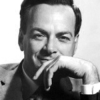Richard P. Feynman

Richard P. Feynman
Richard Phillips Feynmanwas an American theoretical physicist known for his work in the path integral formulation of quantum mechanics, the theory of quantum electrodynamics, and the physics of the superfluidity of supercooled liquid helium, as well as in particle physics for which he proposed the parton model. For his contributions to the development of quantum electrodynamics, Feynman, jointly with Julian Schwinger and Sin-Itiro Tomonaga, received the Nobel Prize in Physics in 1965...
NationalityAmerican
ProfessionPhysicist
Date of Birth11 May 1918
CountryUnited States of America
Richard P. Feynman quotes about
It doesn't seem to me that this fantastically marvelous universe, this tremendous range of time and space and different kinds of animals, and all the different planets, and all these atoms with all their motions, and so on, all this complicated thing can merely be a stage so that God can watch human beings struggle for good and evil - which is the view that religion has. The stage is too big for the drama.
What Do You Care What Other People Think?
We are at the very beginning of time for the human race. It is not unreasonable that we grapple with problems. But there are tens of thousands of years in the future. Our responsibility is to do what we can, learn what we can, improve the solutions, and pass them on.
It turns out that all life is interconnected with all other life.
But see that the imagination of nature is far, far greater than the imagination of man.
Our responsibility is to do what we can, learn what we can, improve the solutions, and pass them on.
Physics is like sex: sure, it may give some practical results, but that's not why we do it.
The easiest person to fool is yourself.
Study hard what interests you the most in the most undisciplined, irreverent and original manner possible.
If you thought that science was certain - well, that is just an error on your part.
I learned very early the difference between knowing the name of something and knowing something.
Religion is a culture of faith; science is a culture of doubt.
To those who do not know mathematics it is difficult to get across a real feeling as to the beauty, the deepest beauty, of nature ... If you want to learn about nature, to appreciate nature, it is necessary to understand the language that she speaks in.
Physics isn't the most important thing. Love is.